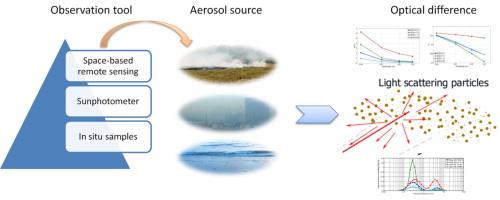Impacts of biomass-burning on aerosol properties of a severe haze event over Shanghai |
| |
| Affiliation: | 1. College of Resources Environment & Tourism, Capital Normal University, Beijing 100048, China;2. School of Mathematical Sciences, Capital Normal University, Beijing 100048, China;3. Faculty of Civil Engineering and Mechanics, Jiangsu University, Zhenjiang 212013, China;4. State Key Laboratory of Remote Sensing Science, Institute of Remote Sensing Science and Engineering, Faculty of Geographical Science, Beijing Normal University, Beijing 100875, China;5. Institute of Remote Sensing and Geographic Information System, School of Earth and Space Science, Peking University, Beijing 100871, China;1. College of Forestry, Fujian Agriculture and Forestry University, Fuzhou 350002, China;2. Co-innovation Center for Soil and Water Conservation in the Red Soil Region of the Cross-straits, Fuzhou 350002, China;3. Li Shui Vocational Technical College, Lishui 323000, China;4. Asia-Pacific Forest Research Centre, Faculty of Forestry, University of British Columbia, Vancouver, BC V6T 1Z4, Canada |
| |
| Abstract: | 
Anthropogenic aerosols have significant impacts on the environment and human health in the Yangtze River Delta region, one of the most densely populated regions in the world. A biomass-burning plume swept across this area (Shanghai) in May 2009, leading to changes in the physical and optical properties of aerosols, which were investigated using ground-based remote sensing and in situ measurements via comparisons with dust pollution and background conditions. Experiments show that the biomass-burning plume led to an increase in the average aerosol optical depth (AOD) at 500 nm from 0.73 to 1.00 (37% higher), an absorption Angstrom exponent (AAE) of 1.48, and an increase in the Angstrom exponent (α) up to 1.53. Furthermore, local dust aerosols derived from road dust and/or construction dust also led to higher values of AOD (2.68) and AAE (2.16), and a daily average value of α of 1.05. For the biomass-burning plume, the aerosol particles exhibited significant variations in short-wavelength spectra. The single scattering albedo at 670 nm decreased remarkably under the influence of the biomass-burning plume, indicating the significant absorptive ability of the biomass-burning pollution and higher ratio of absorption aerosols within the plume. Under the effects of the biomass-burning, the volume concentration of fine-mode aerosols increased significantly and the PM-fine/PM-coarse volume concentration ratio reached 12.33. This relatively large change in fine-mode particles indicates that biomass-burning has a greater impact on fine-mode aerosols than on coarse-mode aerosols. |
| |
| Keywords: | Air pollution Biomass-burning aerosol Sun photometer Optical property |
| 本文献已被 ScienceDirect 等数据库收录! |
|

